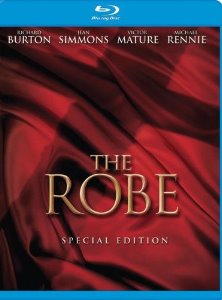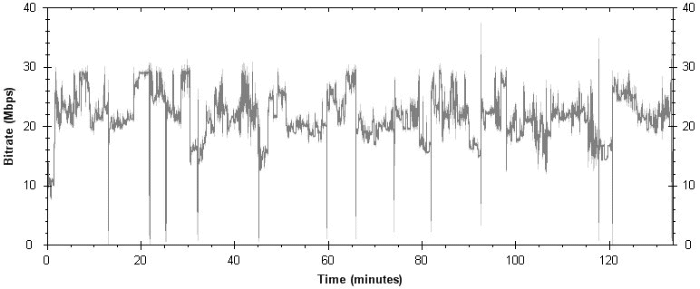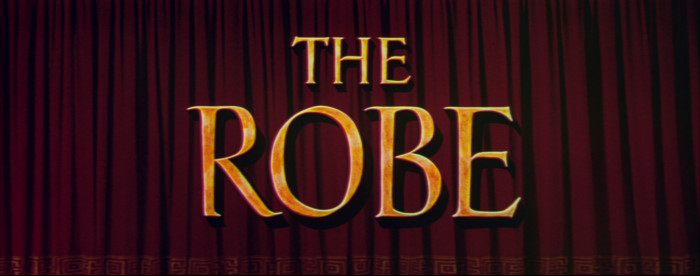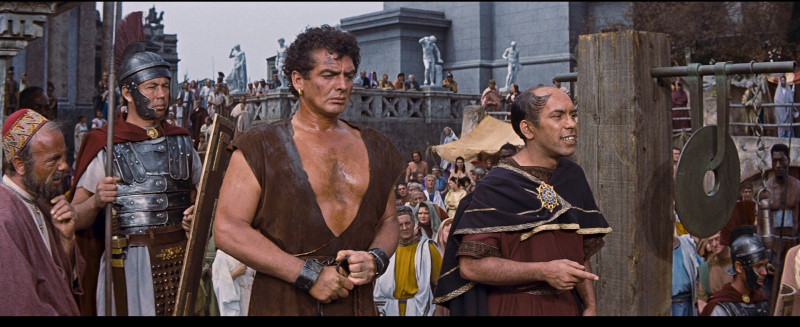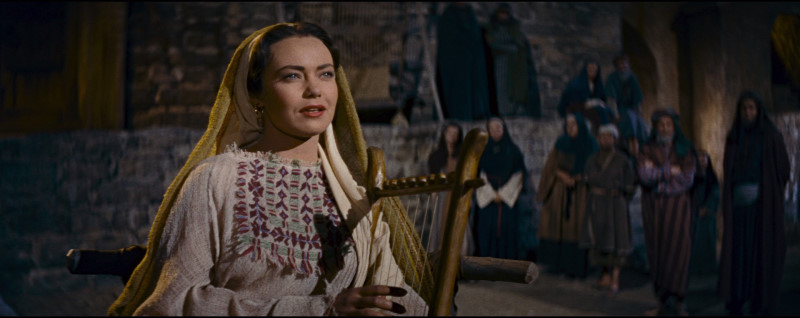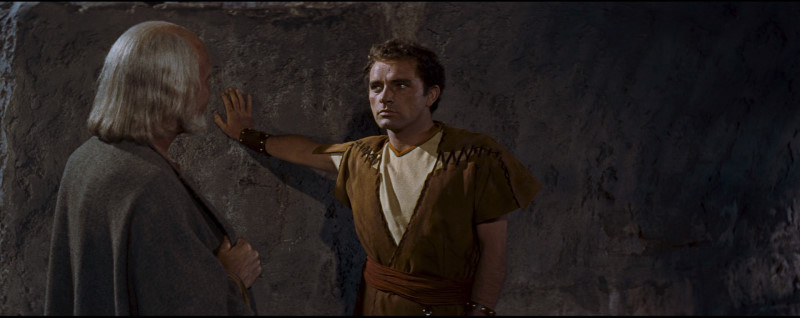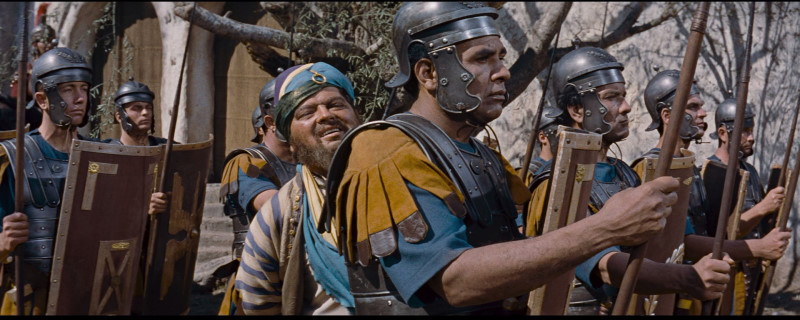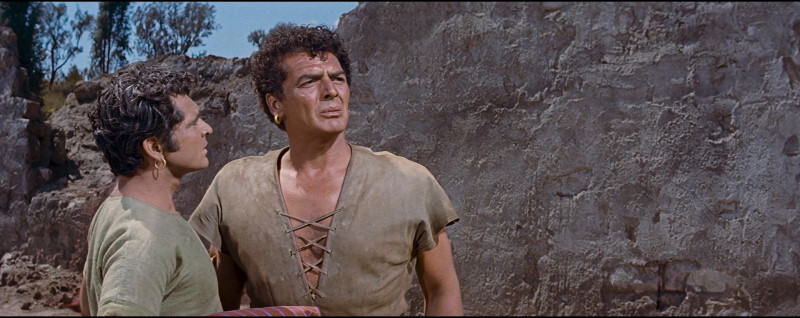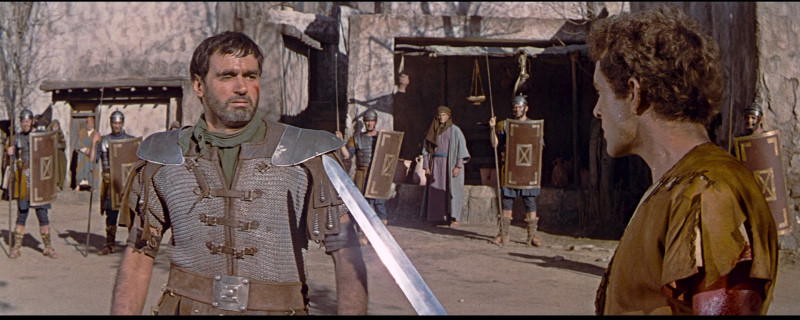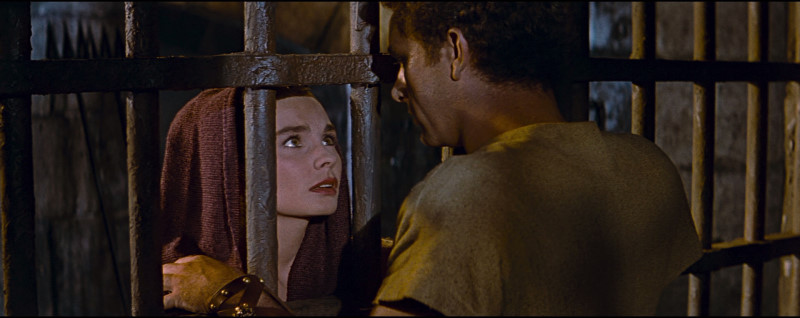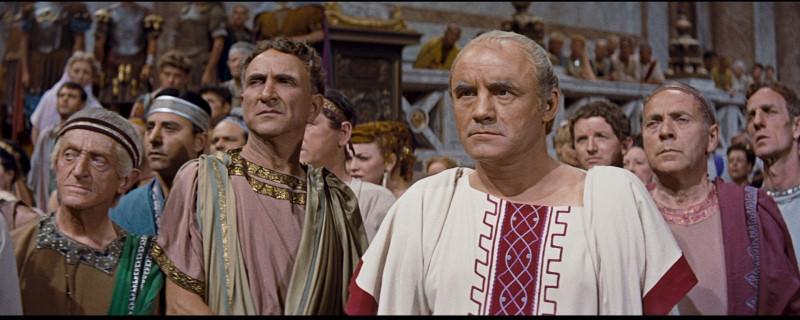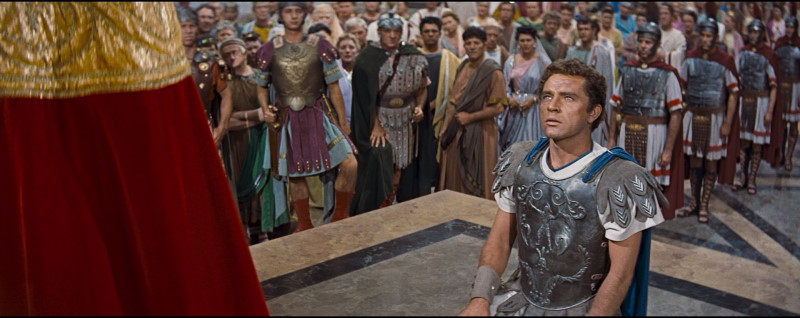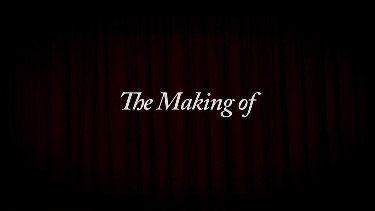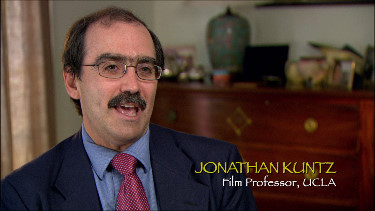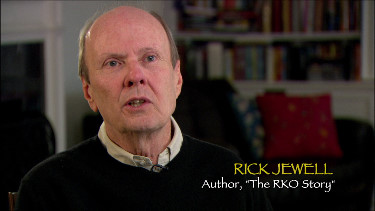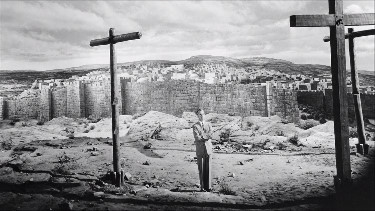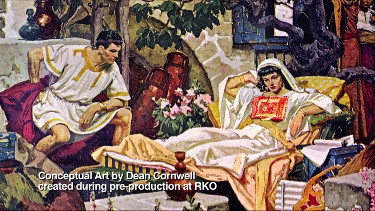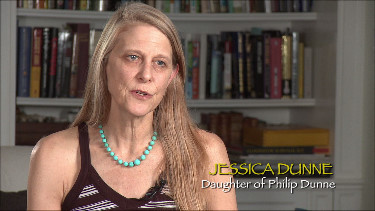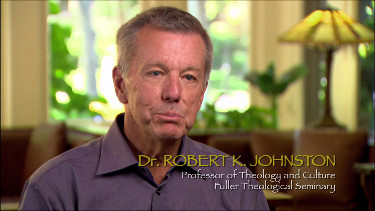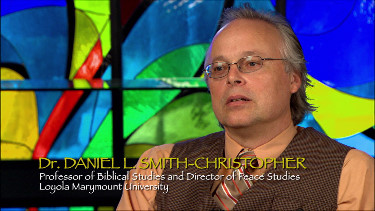Comment:
Fifty-eight years ago on September 30, 1952, the Cinerama
process was introduced at a single theatre in New York
City. Tickets were sold as if for a play, with reserved
seating and premium prices making "This is Cinerama"
was the highest grossing film of the year. But for all its
dimensional, immersive qualities, Cinerama had serious
technical limitations to say nothing of its requirement of a
major reconstruction of the screen, loudspeaker system and
projection booths.
It was a time when the influence of television, even with
black and white sets hardly much larger than 15-inch
diagonals, was siphoning potential audiences out of the
theatre and back into their homes. For all its demonstrable
power Cinerama was limited in its ability to make a dent in
the effects of the little giant. And then one year after
its introduction, in September of 1953, came The Robe
in CinemaScope, advertised – right on the theatre marquee as
3-D without needing glasses. An exagerration to be sure,
but an effective marketing ploy.
CinemaScope's projected image was nearly twice as wide of
nearly all movies until then. It had stereophonic sound,
approximating the location of the actor on the screen, as
well as offering a hint of surround sound. And, best of
all, it required only a special lens for filming plus two
extra microphones for stereo, and for theatrical showing:
only a slightly curved extension of existing screens across
the stage (though in actual practice the screen usually
remained flat), a modest reconstruction of the speaker
layout, and the appropriate projector lens to expand the
squeezed 35 mm image to widescreen whilst maintaining
correct proportionality of the actors – more or less.
CinemaScope itself would soon give way to an assortment of
other widescreen processes with names like SuperScope (The
Invasion of the Body Snatchers), CinemaScope 55 (The
King and I), Todd-A-O (Around the World in 80 Days)
and later: Techniscope (A Fisftful of Dollars). It
was only 3 years after The Robe that Cecil B. DeMille
would remake his own Ten Commandments in VistaVision,
and in 1959 William Wyler would remake Ben-Hur in a
process called MGM Camera 65.
(An historical description of CinemaScope, its
anamorphoscope lens and how the process compared to Cinerama
appears
HERE.
CinemaScope was not the first example of a widescreen
process for motion pictures. Abel Gance used a 3-strip
system for his 1927 Napoleon, and William Fox himself
employed a 70 mm format for his Grandeur process for John
Wayne's first important starring role for The Big Trail
in 1930.
But The Robe had something else going for it. The
studio was smart to delay distribution of How to Mary a
Millionaire, their first movie to be completed in the
new process, until The Robe was ready to demonstrate
the new process. How to Mary a Millionaire was a
pleasant enough piece of romantic comedy and had plenty of
star power in its own right but, except for its widescreen
and sound, it wasn't the right movie to persuade the public
that CinemaScope was the new power in town. The Robe
was just the right movie at the right moment. It had
SPECTACLE.
After The Robe reintroduced us to the historical
costume drama, movies would never be the same again. The
Robe, like The Ten Commandments, is fairly static
in terms of camera movement, but it only took a couple of
years (e.g. Sam Fuller's House of Bamboo) before
directors and crew were comfortable enough in the new medium
that the art form kind of caught up with itself again.
I guess even an introductory comment can't acquit itself
without at least a passing nod to the cast. Richard Burton
had already begun to make a name for himself in My Cousin
Rachel (with Olivia de Haviland, also directed by Henry
Koster) and The Desert Rats (with James Mason as
Field Marshal Rommel and directed by the late Robert Wise).
It would be his starring role as the anguished Marcellus
Gallio that set the stage for Burton's unique style of
speaking, which might be described as groaning with melody.
Jean Simmons made her mark in movies at the age of 17 in
David Lean's
Great Expectations and the following
year in Michael Powell's
Black Narcissus. Over the
next few years he was slowly allowed to blossom into a woman
in front of the camera, and by the time she was cast as
Diana, now 24, she was a knockout, and a good actress as
well. She provides the emotional rudder for Burton's
Marcellus.
Much has been said elsewhere, unfairly I have always felt,
about the casting of Victor Mature as Demetrius. It's his
voice and delivery I think. OK, maybe it doesn't quite fit
the idea of an educated Greek, but otherwise he is as
intensely detached as a Roman slave as he is passionate in
his love of Jesus. And, in a way that would become the
signature cinematic Christian, the way he affects his love
of Marcellus, a man who hated everything that Demetrius
stood for. Not many actors could have stood up to Burton so
convincingly as when he offers him the robe, knowing that it
will tear Marcellus to pieces.
Finally there's the madness of the Emperor Caligula, the
dream of every character actor, one would imagine. Jay
Robinson, who belies his mere 23 years, nails the arbitrary
insanity that John Hurt would flesh out in the BBC's 1976
masterful production of I, Claudius. (Some of you
might remember Robinson from the Star Trek episode
"Elaan of Troyius".) He never had another role that quite
equaled the effect of Caligula, which must have been
discouraging. Jay Robinson is till with us by the way, and
I hope he has a chance to catch himself out again on this
gorgeous new Blu-ray presentation.
The Movie:
8
Synopsis:
Based on a best-selling novel by Lloyd C. Douglas, The
Robe tells the story of a Roman centurion named
Marcellus Gallio (Richard Burton) who is sent to Jerusalem,
charged with overseeing the crucifixion of Jesus Christ.
Marcellus, a cynical and hardened man, wins the robe Jesus
wore to the crucifixion while gambling with other Roman
soldiers. He later becomes convinced that his
hallucinations and violent outbursts are the result of a
curse received from the robe, which is now in the possession
of his escaped slave, Demetrius (Victor Mature).
Emotionally unable to connect with the love of his life,
Diana (Jean Simmons) Marcellus sets out to find Demetrius in
order to destroy the robe and the curse.
Image: 8/9
NOTE: The below Blu-ray captures were
taken directly from the
Blu-ray disc.
The first number indicates a relative level of excellence
compared to other Blu-ray video discs on a ten-point scale.
The second number places this image along the full range of
DVD and Blu-ray discs.
Next to the DVD or any video or theatrical presentation in
memory, this Blu-ray is a revelation, which is not to say
that it is always perfect, but where there are difficulties,
I feel comfortable in attributing them to the source. The
image most often has the feel of a painting in motion, which
I imagine was the intended effect. There is an almost
pastel quality to the color. The lighting is deliberately
evenhanded most of the time, not natural at all, but in
stark contrast to the dramatic material in Palestine that
concerns the robe itself: the crucifixion and Marcellus'
crisis most especially. In those scenes, blacks are intense
and the color deep and sinister. Some of the darkly lit
interior scenes get oversaturated the point of blurring
detail – the result is not subtle, and certainly not
intentional. Artifacts , enhancements or noise reduction do
not appear to be visited upon this Blu-ray.
CLICK EACH
BLU-RAY
CAPTURE TO SEE ALL IMAGES IN FULL 1920X1080 RESOLUTION
Audio & Music: 6/9
The audio in either the 5.1 DTS HD-MA or the original 4.0 is
serviceable, but not without some inherent distortions of
the music and effects. The effects are minor and are
neither overruled nor made more apparent by the lossless
track. Yet it baffles me that Blu-ray production studios
still haven't gotten the hang of uncompressed audio
formats. They seem to feel that its only importance in
regards older films is in boosting a reconstruction of the
original audio track. Oftentimes that track is in mono
(witness the early Bond films), but others, such as The
Robe were stereo, even with surround, though not a full
5.0 or 5.1. To give the reconstruction a DTS HD-MA, but not
the original simply passes understanding.
Operations: 5
I'm not a supporter of the idea that every menu design
should be unique and whose navigation should be a kind of
video game. My idea of a proper menu is that the background
should be appropriate to the main attraction, and that the
windows that come up should present a brief summary of the
bonus features with timings and whose navigation should be
crystal clear. I also prefer to see all of the extra
features in one go, then click on each for details if there
are a lot of them. This menu fails in nearly every
category, though once I got the sense of it, I was able to
use it without much fuss.
Extras: 9
As befits a movie of such historical importance, Fox has
loaded their Blu-ray with high definition extra features,
all of which are new to video. (It came as a surprise to me
that the most recent DVD from 2001 had none.) There are
actually two commentaries: one is continuous and
concentrates largely on how the music is used in the film.
The other is incorporated into one of the two Bonus View
features:
The Robe Times Two: A Comparison of Widescreen and Standard
Versions.
Here Rudy Behlmer and Aubrey Solomon tell us about the two
filmed versions of The Robe: the one in CinemaScope
and the other filmed in alternate takes or by a second
camera positioned elsewhere for regular theatrical academy
ration projection (just in case the new format didn't catch
on.) I found this feature more interesting than the main
audio commentary. The picture-in-picture mode was, for a
change, used to remarkable and insightful advantage. The
commentary is discontinuous with significant gaps from time
to time, but it is relentlessly instructive about
photography and editing.
Most of the other features are what can be expected from the
title: A Seamless Faith: The Real-Life Search for The
Robe is a series of featurettes that consider the
question of Jesus's clothing and Biblical and Roman
costuming in general. It also discusses some of the
historical, political and legendary manifestation of Jesus'
robe. The CinemaScope Story is just that: very EPK,
but still informative. From Scripture to Script
discusses the Bible as a resource for motion picture
scripts. If you hadn't noticed already, the Bible has been
a source of cinematic inspiration from Day 2. And for good
reason: it sanctions sex and violence without condoning it.
Brilliant!
There's about six minutes worth of Movietone News clips
advertising The Robe. (That's "Fox Movietone News" -
right!) The Vintage Celebrity Introductions are a
hoot. Each celeb recites about two sentences in the most
deadpan delivery imaginable inviting the viewer to see this
most awesome of movies. Clifton Webb's is almost too
sinister. We just know he's lying, but does his character?
Recommendation: 10
Perhaps the historical importance of The Robe is of more
significance than the movie on its own terms. It's hard for
me to separate out, since I was there at the Roxy very early
on. That aside, The Robe is a great ride. Everyone but
Simmons and Rennie overacts and yet it all works. God knows
how. The image quality has never been this good since the
movie's first run I imagine – and it looks all the better in
my home theatre since I repainted my Goo Screen with their
latest Ultra Grey paint formulation. The extra features are
entertaining, if occasionally redundant, and often
instructive. A must-own.
Leonard Norwitz
March 19th, 2009
![]()
![]()

![]()
![]()
![]()
![]()

![]()
![]()

